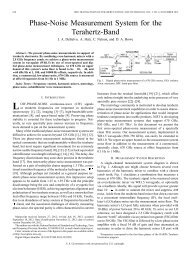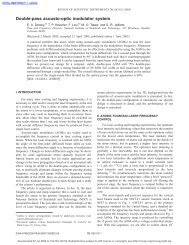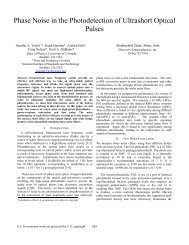Propagation Low-Frequency
Propagation Low-Frequency
Propagation Low-Frequency
You also want an ePaper? Increase the reach of your titles
YUMPU automatically turns print PDFs into web optimized ePapers that Google loves.
1962 Johler: <strong>Propagation</strong> of <strong>Low</strong>- <strong>Frequency</strong> Signal<br />
419<br />
has beeni treated by approximating the medium with<br />
one or more slabs of uniform compositioni as exemplified<br />
by the works of Brekhovskikh [29], Hines [30], Ferraro<br />
and Gibbon [31 J. Such methods have been exploited<br />
by Johler and Harper [27], and carried to the limit,<br />
such that the number of slabs p for each calculation depends<br />
upon the computation precision required and the<br />
particular values of the electric and geometric paranmeters.<br />
The detailed structture of such a flexible model is illustrated<br />
in Fig. 18 as a stack of plasma slabs of arbitrary<br />
thickness (but consistent with computation efficiency)<br />
zn except the topmost slab of thickness zp= co.<br />
The number of such slabs p is also quite flexible, since<br />
the notion is implied in such a model that the measured<br />
electron density-altitude, N(h) or N(z) profile, and collision<br />
frequency altitude, v(h) or v(z) profile, can be approximated<br />
to any desired accuracy by decreasing zn<br />
and increasing p simultaneously until a stable reflection<br />
process is obtained.<br />
A constant electron density and collision frequency<br />
with respect to altitude z is of course assumed for each<br />
slab. A set of four roots -=v of (71) are found to exist<br />
in each slab. Two of the roots will exhibit a negative<br />
imaginary (Im ¢ negative) corresponding to an upgoing<br />
wave (+z direction, Figs. 5 and 18) and two of these<br />
roots will correspond to a positive imaginary (Im r<br />
positive) corresponding to a downgoing wave (-z direction,<br />
Figs. 5 and 18). It is necessary to consider both upgoing<br />
and downgoing waves in the analysis of either the<br />
~at,la,,2ai, 3a,,4al,,6al ,6<br />
bl,lbl,2bl,,3b1,41b,5b1,6<br />
C1,iCl,2il,3C1,4C1,5C1,6<br />
dl,ldl,2d,,3dl,4 d,,5d,,6<br />
a2,3(a2,4 a2,5 a2,6 a2,7a2,8 a2,9a2,l0<br />
b2,3b2,4b2,51b2,6b2,7b2,8b2,9b2,10<br />
C2,3C2,4C2,5C2,6C2,7C2,8 C2,9C2,10<br />
d4,3d2,4d2,5d2,6d2,7d2,8 d2, d2,10<br />
a3,7(a3,8(a3,9a3, 0la3,l1 a3,2 a3,13 a3,14<br />
b3,7b3,8b3,9b3, l0b3, l1b3,12b3,13b3,14<br />
C3,7C3,8C3,9C3,10C3,11 C3,12C3,13C3,14<br />
d3,7d3,8d3,9d3,l0d3,11 d3,12d3,13d3,14<br />
Cp,p+4 .<br />
reflection or transmission process at the ioniosphere,<br />
except for the topmost slab, where only the upgoing<br />
waves are considered.<br />
It is necessary to distiniguish between the ordiniary<br />
and extraordinary magneto-ionic componients of propagation<br />
for both the upgoing anid downgoing waves.<br />
This is accomplished by an examination of the form of<br />
the index of refraction function with respect to frequency<br />
and altitude (or electron density and collision<br />
frequenicy which varies with respect to altitude). Thus,<br />
the index of refractioni v [as defined by (71), (72) ] is detailed<br />
for each frequenicy and slab zn, 7 = 7n,. The upgoing<br />
ordiniary and extraordinary 77)e and the downgoinig<br />
ordinary and extraordinary 1,7),e function conitinuity is<br />
examiined in detail as a function of frequency to determine,<br />
if any, the crossover points of the functions for<br />
each slab or electron density under consideration.<br />
The absolute distinction between ordinary and extraordinary<br />
magneto-ionic wave components [19], [27]<br />
remains quite arbitrary, but the analysis must be consistent<br />
between each slab and consistent within each<br />
slab for upgoing anid downgoing waves.<br />
The reflection and transmission coefficients are determined<br />
by the boundary conditions which express at<br />
the boundary of each slab the principle of continuity<br />
of the tangential E and H and the normal H fields<br />
(Figs. 5 and 18) of the model plasma. These fields are<br />
equated immediately above and below each boundary<br />
and after considerable ado, a matrix equation is obtained<br />
[27],<br />
. .<br />
Cp,p+9<br />
Tein,<br />
T ee)<br />
(1)<br />
Ueioy<br />
(1)<br />
Ueio,<br />
(1)<br />
Uero)<br />
(11)<br />
Tere,<br />
(2)<br />
(2)<br />
Unie,<br />
(2)<br />
U erOy<br />
(2)<br />
Uere)<br />
u(p-i)<br />
Ueio,<br />
(p-i)<br />
Uete)<br />
(p-i)<br />
U erol<br />
(P-1)<br />
U ere<br />
(p)<br />
Ue o<br />
u(p)<br />
beic,<br />
T-M<br />
Tine (1)<br />
(1)<br />
(1)<br />
Ummo<br />
(1)<br />
Umre<br />
(2)<br />
Urnio<br />
(2)<br />
Umie<br />
(2)<br />
U mro<br />
(2)<br />
(p 1)<br />
Umio<br />
(p-I)<br />
Urnie<br />
(p-1)<br />
Umro<br />
(-)<br />
Umte-<br />
aoe)<br />
boe,<br />
Coe<br />
doe)<br />
aom<br />
born<br />
dont<br />
± - O, (73)





